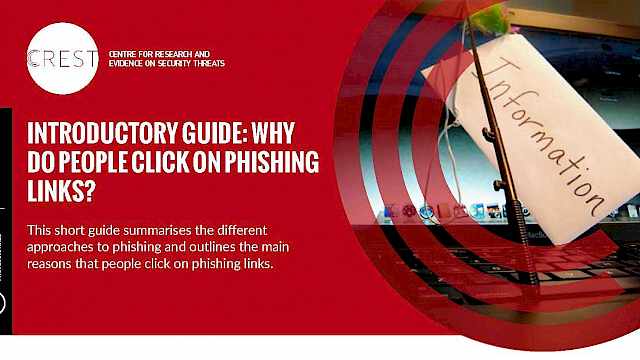Adam Joinson
Professor Adam Joinson holds the post of ‘Professor of Information Systems' at the University of Bath, School of Management.
His research focuses on the interaction between psychology and technology, with a particular focus on how technology can shape behaviour, social relations and attitudes. Adam leads the Understanding And Countering Online Behaviour programme at CREST.
CREST outputs
Projects
Articles
Academic Publications
What demographic attributes do our digital footprints reveal? A systematic review
To what extent does our online activity reveal who we are? Recent research has demonstrated that the digital traces left by individuals as they browse and interact with others online may reveal who they are and what their interests may be. In the present paper we report a systematic review that synthesises current evidence on predicting demographic attributes from online digital traces. Studies were included if they met the following criteria: (i) they reported findings where at least one demographic attribute was predicted/inferred from at least one form of digital footprint, (ii) the method of prediction was automated, and (iii) the traces were either visible (e.g. tweets) or non-visible (e.g. clickstreams). We identified 327 studies published up until October 2018. Across these articles, 14 demographic attributes were successfully inferred from digital traces; the most studied included gender, age, location, and political orientation. For each of the demographic attributes identified, we provide a database containing the platforms and digital traces examined, sample sizes, accuracy measures and the classification methods applied. Finally, we discuss the main research trends/findings, methodological approaches and recommend directions for future research.
(From the journal abstract)
Hinds, J., & Joinson, A. N. (2018). What demographic attributes do our digital footprints reveal? A systematic review. PLOS ONE, 13(11), e0207112.
https://doi.org/10.1371/journal.pone.0207112Characterizing the Linguistic Chameleon: Personal and Social Correlates of Linguistic Style Accommodation
Linguistic style accommodation between conversationalists is associated with positive social outcomes. We examine social power and personality as factors driving the occurrence of linguistic style accommodation, and the social outcomes of accommodation. Social power was manipulated to create 144 face-to-face dyadic interactions between individuals of high versus low power and 64 neutral power interactions. Particular configurations of personality traits (high self-monitoring, Machiavellianism and leadership, and low self-consciousness, impression management and agreeableness), combined with a low-power role, led to an increased likelihood of linguistic style accommodation. Further, greater accommodation by low-power individuals positively influenced perceptions of subjective rapport and attractiveness. We propose individual differences interact with social context to influence the conditions under which nonconscious communication accommodation occurs.
(From the journal abstract)
Muir, K., Joinson, A., Cotterill, R., & Dewdney, N. (2016). Characterizing the Linguistic Chameleon: Personal and Social Correlates of Linguistic Style Accommodation: Characterizing the Linguistic Chameleon. Human Communication Research, 42(3), 462–484.
https://doi.org/10.1111/hcre.12083The Rise of Consumer Health Wearables: Promises and Barriers
Will consumer wearable technology ever be adopted or accepted by the medical community? Patients and practitioners regularly use digital technology (e.g., thermometers and glucose monitors) to identify and discuss symptoms. In addition, a third of general practitioners in the United Kingdom report that patients arrive with suggestions for treatment based on online search results. However, consumer health wearables are predicted to become the next “Dr Google.” One in six (15%) consumers in the United States currently uses wearable technology, including smartwatches or fitness bands. While 19 million fitness devices are likely to be sold this year, that number is predicted to grow to 110 million in 2018. As the line between consumer health wearables and medical devices begins to blur, it is now possible for a single wearable device to monitor a range of medical risk factors. Potentially, these devices could give patients direct access to personal analytics that can contribute to their health, facilitate preventive care, and aid in the management of ongoing illness. However, how this new wearable technology might best serve medicine remains unclear.
(From the journal abstract)
Piwek, L., Ellis, D. A., Andrews, S., & Joinson, A. (2016). The Rise of Consumer Health Wearables: Promises and Barriers. PLOS Medicine, 13(2), e1001953.
https://doi.org/10.1371/journal.pmed.1001953Online risk signals of offline terrorist offending
There has been a rise in the number of terrorist incidents in which social media use has been implicated in the planning and execution of the attack. Efforts to identify online risk signals of terrorist offending is challenging due to the existence of the specificity problem– that while many people express ideologically and hateful views, very few go on to commit terrorist acts. Here, we demonstrate that risk signals of terrorist offending can be identified in a sample of 119,473 online posts authored by 26 convicted right-wing extremists and 48 right-wing extremists who did not have convictions. Combining qualitative analysis with computational modelling, we show that it is not ideological or hateful content that indicates the risk of an offence, but rather content about violent action, operational planning, and logistics. Our findings have important implications for theories of mobilization and radicalization.
(From the journal abstract)
Brown, O., Smith, L. G. E., Davidson, B. I., Racek, D., & Joinson, A. (2023) Online risk signals of offline terrorist offending. PsyArXiv https://doi.org/10.31234/osf.io/hej3r
https://doi.org/10.31234/osf.io/hej3rDigital traces of offline mobilization
Since 2009, there has been an increase in global protests and related online activity. Yet, it is unclear how and why online activity is related to the mobilization of offline collective action. One proposition is that online polarization (or a relative change in intensity of posting mobilizing content around a salient grievance) can mobilize people offline. The identity-norm nexus and normative alignment models of collective action further argue that to be mobilizing, these posts need to be socially validated. To test these propositions, across two analyses, we used digital traces of online behavior and data science techniques to model people’s online and offline behavior around a mass protest. In Study 1a, we used Twitter behavior posted on the day of the protest by attendees or nonattendees (759 users; 7,592 tweets) to train and test a classifier that predicted, with 80% accuracy, who participated in offline collective action. Attendees used their mobile devices to plan logistics and broadcast their presence at the protest. In Study 1b, using the longitudinal Twitter data and metadata of a subset of users from Study 1a (209 users; 277,556 tweets), we found that participation in the protest was not associated with an individual’s online polarization over the year prior to the protest, but it was positively associated with the validation (“likes”) they received on their relevant posts. These two studies demonstrate that rather than being low cost or trivial, socially validated online interactions about a grievance are actually key to the mobilization and enactment of collective action.
(From the journal abstract)
Smith, L. G. E., Piwek, L., Hinds, J., Brown, O., & Joinson, A. (2023). Digital traces of offline mobilization. Journal of Personality and Social Psychology, 125(3), 496–518. https://doi.org/10.1037/pspa0000338
https://doi.org/10.1037/pspa0000338
Projects
Articles
Academic Publications
What demographic attributes do our digital footprints reveal? A systematic review
To what extent does our online activity reveal who we are? Recent research has demonstrated that the digital traces left by individuals as they browse and interact with others online may reveal who they are and what their interests may be. In the present paper we report a systematic review that synthesises current evidence on predicting demographic attributes from online digital traces. Studies were included if they met the following criteria: (i) they reported findings where at least one demographic attribute was predicted/inferred from at least one form of digital footprint, (ii) the method of prediction was automated, and (iii) the traces were either visible (e.g. tweets) or non-visible (e.g. clickstreams). We identified 327 studies published up until October 2018. Across these articles, 14 demographic attributes were successfully inferred from digital traces; the most studied included gender, age, location, and political orientation. For each of the demographic attributes identified, we provide a database containing the platforms and digital traces examined, sample sizes, accuracy measures and the classification methods applied. Finally, we discuss the main research trends/findings, methodological approaches and recommend directions for future research.
(From the journal abstract)
Hinds, J., & Joinson, A. N. (2018). What demographic attributes do our digital footprints reveal? A systematic review. PLOS ONE, 13(11), e0207112.
Characterizing the Linguistic Chameleon: Personal and Social Correlates of Linguistic Style Accommodation
Linguistic style accommodation between conversationalists is associated with positive social outcomes. We examine social power and personality as factors driving the occurrence of linguistic style accommodation, and the social outcomes of accommodation. Social power was manipulated to create 144 face-to-face dyadic interactions between individuals of high versus low power and 64 neutral power interactions. Particular configurations of personality traits (high self-monitoring, Machiavellianism and leadership, and low self-consciousness, impression management and agreeableness), combined with a low-power role, led to an increased likelihood of linguistic style accommodation. Further, greater accommodation by low-power individuals positively influenced perceptions of subjective rapport and attractiveness. We propose individual differences interact with social context to influence the conditions under which nonconscious communication accommodation occurs.
(From the journal abstract)
Muir, K., Joinson, A., Cotterill, R., & Dewdney, N. (2016). Characterizing the Linguistic Chameleon: Personal and Social Correlates of Linguistic Style Accommodation: Characterizing the Linguistic Chameleon. Human Communication Research, 42(3), 462–484.
The Rise of Consumer Health Wearables: Promises and Barriers
Will consumer wearable technology ever be adopted or accepted by the medical community? Patients and practitioners regularly use digital technology (e.g., thermometers and glucose monitors) to identify and discuss symptoms. In addition, a third of general practitioners in the United Kingdom report that patients arrive with suggestions for treatment based on online search results. However, consumer health wearables are predicted to become the next “Dr Google.” One in six (15%) consumers in the United States currently uses wearable technology, including smartwatches or fitness bands. While 19 million fitness devices are likely to be sold this year, that number is predicted to grow to 110 million in 2018. As the line between consumer health wearables and medical devices begins to blur, it is now possible for a single wearable device to monitor a range of medical risk factors. Potentially, these devices could give patients direct access to personal analytics that can contribute to their health, facilitate preventive care, and aid in the management of ongoing illness. However, how this new wearable technology might best serve medicine remains unclear.
(From the journal abstract)
Piwek, L., Ellis, D. A., Andrews, S., & Joinson, A. (2016). The Rise of Consumer Health Wearables: Promises and Barriers. PLOS Medicine, 13(2), e1001953.
Online risk signals of offline terrorist offending
There has been a rise in the number of terrorist incidents in which social media use has been implicated in the planning and execution of the attack. Efforts to identify online risk signals of terrorist offending is challenging due to the existence of the specificity problem– that while many people express ideologically and hateful views, very few go on to commit terrorist acts. Here, we demonstrate that risk signals of terrorist offending can be identified in a sample of 119,473 online posts authored by 26 convicted right-wing extremists and 48 right-wing extremists who did not have convictions. Combining qualitative analysis with computational modelling, we show that it is not ideological or hateful content that indicates the risk of an offence, but rather content about violent action, operational planning, and logistics. Our findings have important implications for theories of mobilization and radicalization.
(From the journal abstract)
Brown, O., Smith, L. G. E., Davidson, B. I., Racek, D., & Joinson, A. (2023) Online risk signals of offline terrorist offending. PsyArXiv https://doi.org/10.31234/osf.io/hej3r
Digital traces of offline mobilization
Since 2009, there has been an increase in global protests and related online activity. Yet, it is unclear how and why online activity is related to the mobilization of offline collective action. One proposition is that online polarization (or a relative change in intensity of posting mobilizing content around a salient grievance) can mobilize people offline. The identity-norm nexus and normative alignment models of collective action further argue that to be mobilizing, these posts need to be socially validated. To test these propositions, across two analyses, we used digital traces of online behavior and data science techniques to model people’s online and offline behavior around a mass protest. In Study 1a, we used Twitter behavior posted on the day of the protest by attendees or nonattendees (759 users; 7,592 tweets) to train and test a classifier that predicted, with 80% accuracy, who participated in offline collective action. Attendees used their mobile devices to plan logistics and broadcast their presence at the protest. In Study 1b, using the longitudinal Twitter data and metadata of a subset of users from Study 1a (209 users; 277,556 tweets), we found that participation in the protest was not associated with an individual’s online polarization over the year prior to the protest, but it was positively associated with the validation (“likes”) they received on their relevant posts. These two studies demonstrate that rather than being low cost or trivial, socially validated online interactions about a grievance are actually key to the mobilization and enactment of collective action.
(From the journal abstract)
Smith, L. G. E., Piwek, L., Hinds, J., Brown, O., & Joinson, A. (2023). Digital traces of offline mobilization. Journal of Personality and Social Psychology, 125(3), 496–518. https://doi.org/10.1037/pspa0000338






